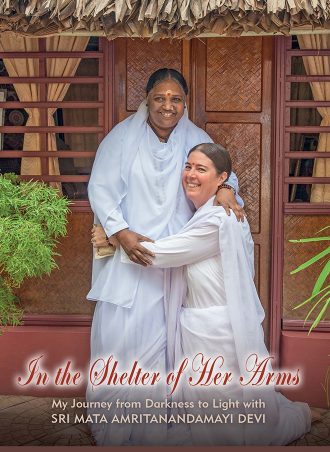Archive : Spiritual | Amrita Books
The Eternal Beauty That We Are
₹140.00 Original price was: ₹140.00.₹110.00Current price is: ₹110.00.
ജ്യോതിർഗമയ ഭാഗം മൂന്ന് (Lead us to Light 3 – Malayalam)
₹160.00 Original price was: ₹160.00.₹144.00Current price is: ₹144.00.
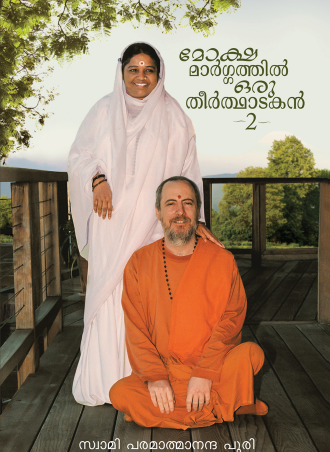
This book has been written on the insistence of a few fellow seekers who felt that my life and experiences with some of the real sages of India over the past twenty-eight years would be interesting and useful to other aspirants on the spiritual path. On hearing their request, I was immediately reminded of the words of one of those saints who told me that only a Self-Realized Soul should write a book on spirituality. If an ignorant person (one who has not realized the Truth) should do so, he would only fall into the trap of egoism and have a spiritual downfall. I told the same to these well-wishers who, however, persisted in their requests. At last I told them that if my spiritual Master, Mata Amritanandamayi, should tell me to write a book, only then would I do it, knowing that Her Grace would protect and guide me. After these friends had approached and spoken to Her, She told me that I should write the book as a service to other aspirants. Though this book takes the form of an autobiography, its sole purpose is to bring out the greatness and methods of teaching of the mahatmas (sages) of India. If one feels inspired to seek their holy company and get the wonderful fruits thereof after reading it, then it has more than fulfilled its purpose.
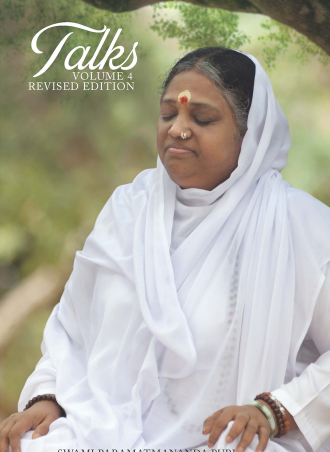
Since 1968, Swami Paramatmananda Puri has lived the life of a renunciate in India, settling there at the age of nineteen, to imbibe the spiritual essence of that great and ancient culture. It has been his good fortune to have kept the company of many saints and sages over the years, culminating in his meeting with his Guru, Mata Amritanandamayi, in 1979. As one of her senior disciples, he was eventually asked to return to the U.S. to serve as head of the first ashram in the West, the Mata Amritanandamayi Center, where he remained in residence since from 1990 until 2001.
Many residents and visitors to the Center have shared that one of the high points in programs there have been Swami’s talks, encompassing Amma’s teachings, his experiences in India, his understanding of scriptural texts, and his life on the spiritual path. With wit and humour, he has synthesized East and West, and created a forum for spiritual learning for people from all walks of life. Originally available only on tape, his talks have now been transcribed, making these volumes a treasury of wisdom for years to come. These talks were recorded over twenty years ago. For this revised edition, Swamiji decided to rewrite the book in a more readable style.

Samsara — the ceaseless flow of existence, characterized by the swirl of worldly life and by the cycle of birth, death and rebirth — is often likened to a sea. A seeker of Truth must crossthis vast realm of transmigration in order to attain moksha, spiritual liberation. The key to a successful crossing is ishwara kripa, God’s grace. How does one earn kripa? By clinging to God, the way a monkey clings to its mother? Or, as with a young kitten, by allowing the Divine Mother to pick one up by the scruff of one’s neck, as it were? By being both the monkey and kitten, i.e. by striving and surrendering, for they are different phases of the journey to God. Amma says as much. She defines the word ‘ashram’ (generally translated as ‘monastery’) as “aa shramam” — “that effort” (one makes to reach the spiritual goal). From this, it is clear that She endorses sadhana (spiritual striving). However, Amma time and again stresses that more than human effort, what one needs is divine grace. What exactly is grace? It is the X-factor that crowns struggle with success. It manifests as the noble impulse to do good and to turn Godward. Though intangible, kripa is palpable, as legions of devotees will affirm. This book is a testament to the waves of divine grace that have anointed their pilgrimage through life.
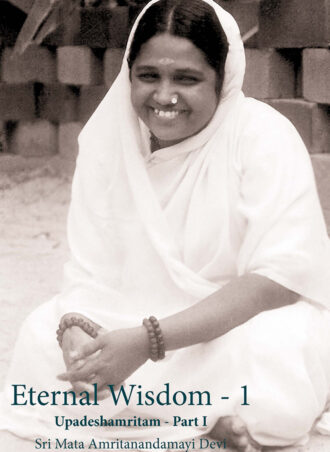
Rare indeed is the mahatmas (great souls) endowed with the vision of seeing the entire universe within the Atman (Self ), and the Atman within the universe. Even if they are recognized, they may not be inclined to communicate with us or counsel us, immersed as they are in the eternal silence of the Self. Therefore, it is our great fortune when a fully realized mahatma is ready to advise and discipline us with the tender love of a mother, and the inexplicable compassion of a guru. Throughout the world today, the darshan and the nectarous words of Sri Mata Amritanandamayi Devi are effecting transformations in the lives of hundreds of thousands of people. This book, though incomplete, is a precious collection of conversations between the Holy Mother and Her disciples, devotees, and inquiring visitors during the period from June 1985 to September 1986. The wisdom of the mahatmas, who have come with the mission of uplifting the world, has both immediate and eternal meaning. Even though they elucidate everlasting values, they are attuned to the call of the times in which they live, and their words are in response to the heartbeat of their listeners. Mother speaks Her immortal words, which transform society, at a time when the man has lost his traditional values, nobler sentiments, and peace of mind in the frenzied attempt to reinforce the outer world of sensory pleasures, power, and prestige. Man’s senseless pursuit of these distractions, while he remains oblivious of his own Self, has cost him the harmony and graciousness of his life. Lack of faith, fear, and a sense of competition has destroyed personal ties and family relations. Love has become no more than a mirage in a culture of excessive consumerism.
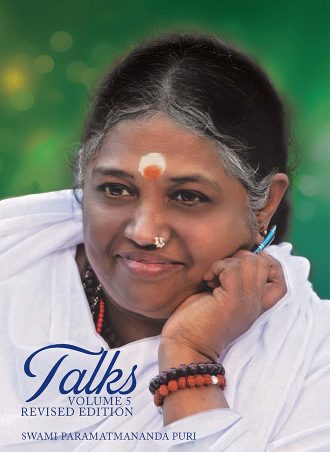
Since 1968, Swami Paramatmananda Puri has lived the life of a renunciate in India, moving there at the age of nineteen, to imbibe the spiritual essence of that great and ancient culture. It has been his good fortune to have kept the company of many saints and sages over the years, culminating in his meeting with his Guru, Mata Amritanandamayi, in 1979. As one of her senior disciples, he was eventually asked to return to the U.S. to serve as head of the first ashram in the West, the Mata Amritanandamayi Center, where he remained in residence from 1990 till 2001. Many residents and visitors to the Center have shared that one of the high points in programs there have been Swami’s talks, encompassing his experiences in India, his understanding of scriptural texts, and his life on the spiritual path. With wit and humor, he has synthesized East and West and created a forum for spiritual learning for people from all walks of life. Originally available only on tape, his talks have now been transcribed, with his speaking style preserved as much as possible, making these volumes a treasury of wisdom for years to come.

Amma’s words present a simpler version of the same truths found in the ancient scriptures. Hence, they carry the same beauty and profundity as the knowledge shared by the ancient seers. They really require no introduction. However, to truly understand their meaning, it is not enough to merely read them. One has to meditate upon them—to go beneath their surface and dive deep. Then, we find that, just as a tree is hiding inside each seed, a world of knowledge is hiding inside Amma’s every word. They have tremendous power—the power to quieten our mind and help us come face to face with God, our true nature.”
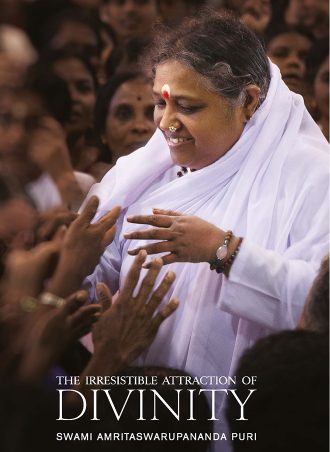
Love is the only thing in the whole world that has an irresistible attraction. It is the most predominant feeling inherent in all living beings. Regardless of our background, nationality, language and the section of society we belong to, the power of love remain common to all of humanity, perhaps to the entire creation.
Though the energy behind love is the same, it manifests diversely depending on each person’s samskara (latent tendencies). This is how Amma puts it, “For a scientist, love means protons and neutrons. A poet or orator considers words like love, while food is love for some. Love for the near and dear ones is common. Color is love for an artist. A baby’s love is for its mother, and for a honeybee it is flowers. But for a devotee, God is love. Similarly, for a disciple, the guru is love.”
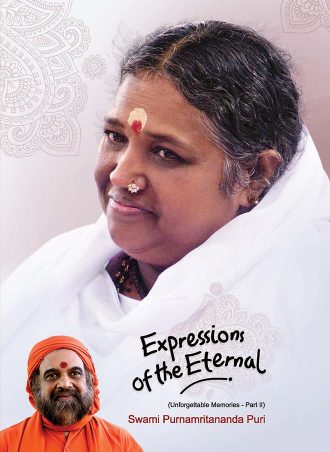
Swami Purnamritananda Puri is the General Secretary, Mata Amritanandamayi Math. One of the earliest disciples of Amma, he was fortunate to have met Amma while still a science student. The seeker who set out to probe the mysteries of creation found himself in the presence of the Guru. Research on the light giver of the solar system saw him face to face with the Effulgence that illumines the infinite cosmos. This book is a captivating account of the journey of a researcher with the solar radiation department of the Raman Research Institute, Bangalore, to Amma, the embodiment of Spiritual Glory.
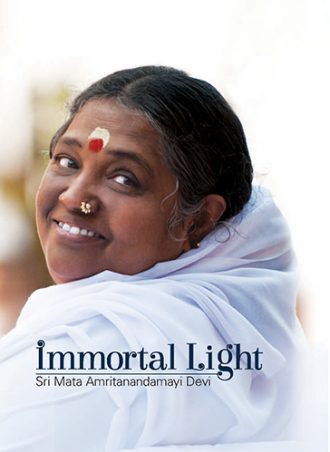
Amrita Jyoti or Immortal Light – is Advice to Householders. There is an everlasting Truth that remains immutable throughout time. To realize this Truth is the goal of human life. From time to time great souls appear in our midst to take us by the hand and guide us to that Truth. Adding the sweetness of their own experiences these great souls impart to us the message of the scriptures in a style that suits the age and culture into which they are born.
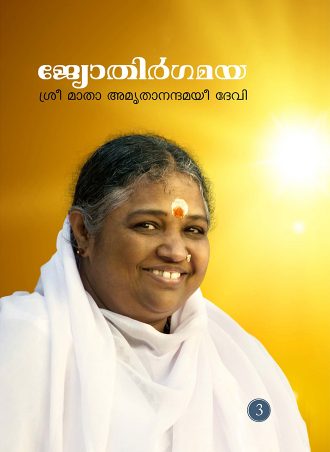
മാതൃവാണിയില് പ്രസിദ്ധീകരിച്ച അമ്മയുടെ സന്ദേശങ്ങളുടെ സമാഹാരമാണു ജ്യോതിര്ഗമയ.
ഈ ഗ്രന്ഥത്തില് രണ്ടു ഭാഗങ്ങളിലായാണു് അമ്മയുടെ സന്ദേശങ്ങള് സമാഹരിച്ചിട്ടുള്ളതു്. ആദ്യഭാഗം, മാതൃവാണി യില് പ്രതിമാസം പ്രസിദ്ധീകരിക്കാനുദ്ദേശിച്ചു നല്കിയ സന്ദേശങ്ങളും രണ്ടാംഭാഗം ‘അമൃതോത്സവം’ എന്ന പേരില്, ഓണം, വിഷു, നവരാത്രി, ശിവരാത്രി, സ്വാതന്ത്ര്യദിനം തുടങ്ങിയ വിശേഷാവസരങ്ങളില് അമ്മ നല്കിയ സന്ദേശങ്ങളുമാണുള്ളതു്.
രണ്ടു ഭാഗങ്ങളിലെയും സന്ദേശങ്ങള്ക്കു നിത്യജീവിതത്തില് അത്യന്തം പ്രസക്തിയുണ്ടു്. ഇവയെല്ലാം വായിച്ചു മനനം ചെയ്തു് ഉള്ക്കൊണ്ടു ജീവിതം നയിച്ചാല് നമ്മുടെയെല്ലാം ജന്മം ധന്യമാകുമെന്നതിനു തര്ക്കമില്ല. അമ്മയുടെ വചനങ്ങള് ആദ്ധ്യാത്മികതത്ത്വരഹസ്യങ്ങള് നിറഞ്ഞവയാണു്. അവ വര്ത്തമാനസമൂഹത്തെ പൂര്ണ്ണമായും കണക്കിലെടുത്തുകൊണ്ടുള്ളവയാണു്. ഋഷിമാര് കണ്ടെത്തിയ സനാതനമായ ആത്മതത്ത്വങ്ങളും പ്രപഞ്ചരഹസ്യങ്ങളും ജീവിതാദര്ശങ്ങളും സാധനോപദേശങ്ങളുമെല്ലാം ഇന്നത്തെ ജനങ്ങള്ക്കു പ്രയോജനപ്പെടുന്ന വിധത്തില് അമ്മ അവതരിപ്പിക്കുന്നു. അദ്ധ്യയനം ചെയ്യുന്നവര്ക്കു് അവ ഉള്ക്കാഴ്ചയും മാര്
ഗ്ഗദര്ശനവും നല്കുന്നു. വീണ്ടും വീണ്ടും അനുസന്ധാനം ചെയ്തു് അര്ത്ഥം ഗ്രഹിക്കപ്പെടേണ്ടവയാണു് അമ്മയുടെ വചനരചനകള്.
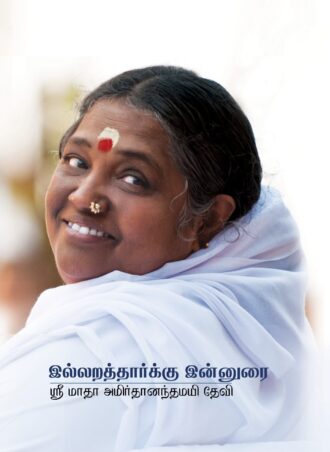
LLARATHARKU INNURAIAmrita Jyoti or Immortal Light – is Advice to Householders. There is an everlasting Truth that remains immutable throughout time. To realize this Truth is the goal of human life. From time to time great souls appear in our midst to take us by the hand and guide us to that Truth. Adding the sweetness of their own experiences these great souls impart to us the message of the scriptures in a style that suits the age and culture into which they are born.


